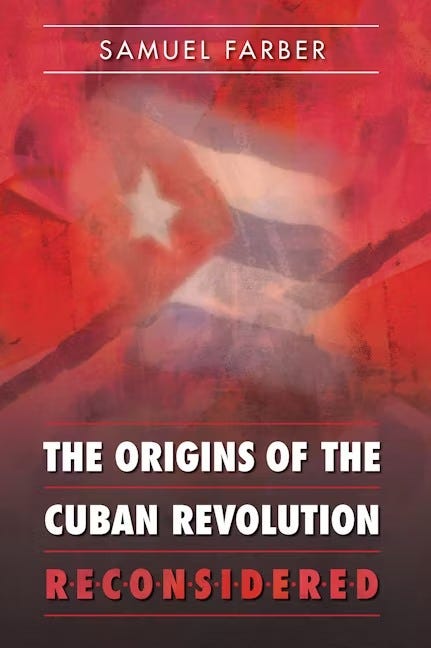Thoughts on The Origins of the Cuban Revolution Reconsidered by Samuel Farber
Image description: Picture of the book cover, which consists of the book’s title around a picture of the Cuban flag on top of a red background.
This book has several merits. First, it analyses how the objective conditions for the Cuban Revolution happening were Cuba’s neocolonial relationship of economic dependency on American capitalist imperialism through its sugar industry that resulted in combined and uneven economic development and stagnation.
Second, it details how Fidel Castro and his fellow revolutionaries’ actions before and during the Cuban Revolution arose from Cuban left-wing populism and how they were a declassed group of revolutionaries.
Third, it analyses how the American capitalist imperialist state’s response to the Cuban Revolution shifted from being initially cautious to seeking to overthrow it after they concluded that they could not co-opt it like they did with the 1952 Bolivian Revolution.
Fourth, it details how Fidel Castro and the 26th July Movement were able to achieve leadership over the multi-class Cuban revolutionary movement due to the weakness of the other political tendencies and how the inability of the Cuban bourgeoisie to fully exercise hegemony over the Cuban proletariat while the latter could not overthrow the former allowed Castro to function as a Bonapartist caudillo, which gave the Cuban Revolution its distinctive character.
Fifth, it analyses how the Soviet Union shifted from being uninterested in supporting the Cuban Revolution to supporting it due to intensifying geopolitical competition with the USA and Maoist China, how the Cuban revolutionary leadership decided in the course of the Cuban Revolution to adopt the Soviet model due to the common affinities between Cuban left-wing populism and the Soviet Union as well as due to the neocolonial domination of American capitalist imperialism and how the Cuban Stalinists while being a minority tendency in the Cuban revolutionary movement served as a key intermediary between the Cuban revolutionaries and the Soviet Union.
Sixth, it provides strong critiques of conservative arguments that the Castro planned to implemented the Soviet model from the outset and liberal arguments that the Cuban Revolution adopted the Soviet model due to US government intransigence by demonstrating that the Cuban revolutionary leadership adopted the Soviet model as the most viable means to achieve their ends under the geopolitical and economic constraints they were in.
However, this book does have its issues. First, while it does briefly discuss the position of women and black Cubans prior to the Cuban Revolution, it does not analyse the gender and racial relations of Cuba before and during the revolution, making its analysis partial at most.
Second, while it briefly refers to Cuban anarchism and Trotskyism, it does not provide a detailed examination of either movement before and during the Cuban Revolution, which deprives it of an avenue to refute conservative historiography of the Cuban Revolution.
Third, it vaguely talks about the Soviet Union not being capitalist or socialist but does not provide a theory of the political economy and international relations of the Soviet Union and as a result it describes it’s actions in relation to Cuba being contradictory, incoherent and cynical.
Overall, I’d recommend this book, as it provides a Marxist analysis of the causes of the Cuban Revolution that refutes liberal and conservative historiography on it.


